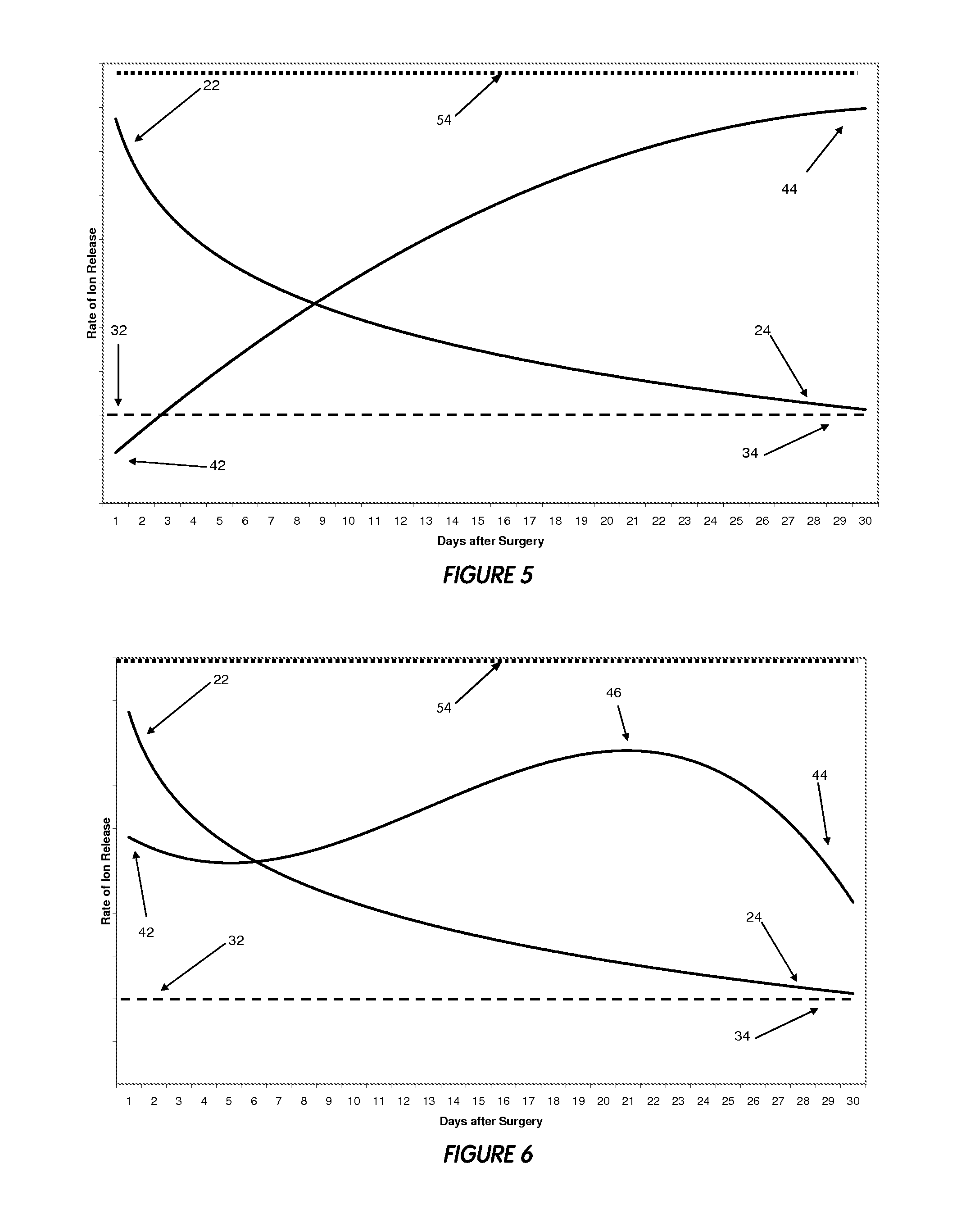Gradient coating for biomedical applications
a biomedical and composition technology, applied in the direction of biocide, drug composition, prosthesis, etc., can solve the problems of reducing the risk of infection, invasive surgery, devastating surgery, etc., and achieve the effect of reducing the risk or preventing infection
- Summary
- Abstract
- Description
- Claims
- Application Information
AI Technical Summary
Benefits of technology
Problems solved by technology
Method used
Image
Examples
embodiment 1
[0166]In one embodiment of the present invention, there is provided an antimicrobial coating having calcium phosphate and a gradient distribution of at least one metal content, such as silver, zinc, copper, in the coating. The at least one metal content may be high in the outer surface of the coating and low in the inner surface. This metal gradient-CaP coating may be achieved by dipping the implant in sequence into different sol-gel solutions, each solution having a different gradient metal concentration. The metal gradient calcium phosphate coating may include single phase calcium phosphate, such as HA, and / or may also include multiple calcium phosphate phases, such as biphasic calcium phosphates. The advantage of using a sol-gel process is that the coating may be applied to a porous ingrowth structure without leaving any portions left uncoated. While at least one sol-gel process is preferred, other primary or subsequent processes known in the art may be used.
embodiment 2
[0167]In another embodiment of the present invention, a metallic substrate, such as silver, zinc, copper, etc., and calcium phosphate, such as HA, TCP, Ag—CaP, etc., is combined to form a composite antimicrobial coating comprised of several layers. The composite coating may be applied to an implant through the use of a plasma-spraying process, although other processes discussed herein may be used. The metallic substrate may be in the form of a powder that may be mixed together with calcium phosphate powders and co-sprayed onto an implant surface simultaneously. Alternatively, the metallic substrate and calcium phosphate powders may be applied individually, layer by layer, to an implant surface. The order in which each layer is applied may be predetermined to provide the best solution for an individual patient's needs. The gradient in the plasma-sprayed coating may be accomplished by feeding the metallic substrate powders and calcium phosphate powders into a hopper at different rates...
embodiment 3
[0168]In yet another embodiment of the present invention, an antimicrobial calcium phosphate coating is provided, the coating having at least one metal, such as copper, silver, zinc, etc. The antimicrobial coating further comprises a gradient degradation profile. In other words, an outer layer of the coating may have a faster dissolution rate than an inner layer of the coating. Such a dissolution rate profile may be employed to force an outer portion of the coating to dissolve quicker, thereby creating a burst release of an antimicrobial agent. To accomplish a gradient degradation profile, an outer layer might utilize a more degradable calcium phosphate, whereas the inner surface layer might utilize a more stable calcium phosphate. Because multiple phases (or layers) of calcium phosphates may be used in the coating, some calcium phosphates used may or may not have a metal in their compositions. Likewise, some calcium phosphates used in the coating layers may or may not have osseoind...
PUM
| Property | Measurement | Unit |
|---|---|---|
| time | aaaaa | aaaaa |
| thickness | aaaaa | aaaaa |
| thick | aaaaa | aaaaa |
Abstract
Description
Claims
Application Information
 Login to View More
Login to View More - R&D
- Intellectual Property
- Life Sciences
- Materials
- Tech Scout
- Unparalleled Data Quality
- Higher Quality Content
- 60% Fewer Hallucinations
Browse by: Latest US Patents, China's latest patents, Technical Efficacy Thesaurus, Application Domain, Technology Topic, Popular Technical Reports.
© 2025 PatSnap. All rights reserved.Legal|Privacy policy|Modern Slavery Act Transparency Statement|Sitemap|About US| Contact US: help@patsnap.com



